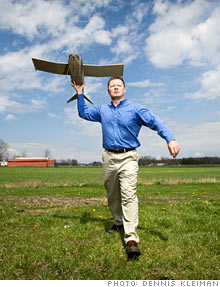Fly kid grounded
A young Pentagon contractor and his tiny spy planes take on the FAA.
 |
| Theiss with one of his unmanned aircraft, the Ferret. |
(Fortune Small Business) -- Shawn Theiss was an aerial prodigy.
At age nine he built his first working airplane -- equipped with a solar-powered propeller. At 19 he ditched a lucrative career as a pilot and founded Theiss Aviation, an Ohio-based company that built tiny spy planes for the U.S. military. His mom served as treasurer, his dad as VP. By the time he was 25, Theiss and 10 employees were churning out handcrafted, 10-foot-long planes at $70,000 apiece -- a tenth of what the Pentagon normally paid for unmanned aircraft.
Theiss's first model was the Dakota-II, followed by the Ferret, the Tarzan and, most recently, the TIC (Tactical Information Craft). A remote-controlled plane that fits in your hand, the TIC is equipped with chemical and biological sensors. Minimally trained operators can send it aloft in minutes.
But the FAA wants to treat these palm-size planes like full-size aircraft -- meaning a prohibitive amount of paperwork for prospective buyers.
Theiss, now 38, is targeting emergency and private security services across the U.S. During a search-and-rescue, he says, "it would be great for a local police department to get one of our planes in the air." At $6,000, the TIC is far cheaper than manned helicopters (around $300,000 apiece) or private planes (entry-level Cessnas go for $111,000 each). TICs can even be launched from the trunk of a car, Theiss says.
But for aviation officials, who are enforcing rules more stringently since 9/11, size doesn't matter. The FAA refuses to distinguish between Theiss's tiny planes and full-scale drone aircraft, such as the Predators currently deployed on the Afghan-Pakistani border.
So here's what every TIC owner must do to be certified: submit detailed drawings of every part of the plane, wait three months, answer any FAA questions, then wait another month for a registry number.
Finally, the tiny drone must be cleared to leave the ground by FAA officials every time it flies. For drones, most flight plans must be filed 60 days ahead of time.
"The size of the unmanned air system doesn't matter," says Alison Duquette, an FAA spokesperson. "Any size could pose a danger to private or commercial planes." Also, officials point out, the TIC is too small to be tracked via radar.
Critics argue that the agency is being squeamish about a technology that would help public safety more than harm it.
"Small unmanned planes are not rocket science," says Dave Nestic, entrepreneur in residence at JumpStart TechLift Advisors, a Cleveland incubator that studies the propulsion market.
Theiss, stymied in his bid to sell to anyone but the military, is still fuming. The FAA is "not aviation-minded," he says. "It's regulation-minded." ![]()
-
The Cheesecake Factory created smaller portions to survive the downturn. Play
-
A breeder of award-winning marijuana seeds is following the money and heading to the U.S. More
-
Most small businesses die within five years, but Amish businesses have a survival rate north of 90%. More
-
The 10 most popular franchise brands over the past decade -- and their failure rates. More
-
These firms are the last left in America making iconic products now in their twilight. More








